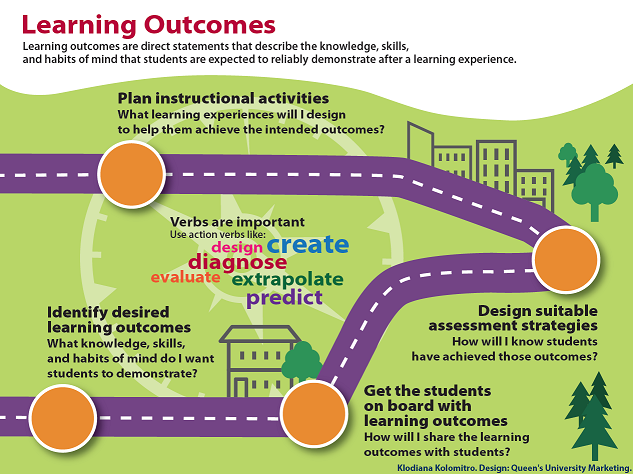As a teaching assistant, you will be the first point of contact for many students. They will turn to you for feedback and with questions on assignments and course material. Explicitly communicating your role and expectations will be key. Whether you are TAing a face-to-face or online course, here are some things you might want to consider:
Sections:
Learning Outcomes
Strategies for Effective Communication with Students
Universal Design for Learning (UDL)
Learning Outcomes
 Learning outcomes are direct statements that describe the knowledge, skills, and habits of mind that students are expected to demonstrate after a learning experience. Learning outcomes are described ‘as a basic educational building block’ and they provide a powerful framework to build a course/program. As a TA, it can helpful to know the course learning outcomes and how your role as a TA will help students achieve these outcomes. At the CTL we can help you:
Learning outcomes are direct statements that describe the knowledge, skills, and habits of mind that students are expected to demonstrate after a learning experience. Learning outcomes are described ‘as a basic educational building block’ and they provide a powerful framework to build a course/program. As a TA, it can helpful to know the course learning outcomes and how your role as a TA will help students achieve these outcomes. At the CTL we can help you:
- Develop effective learning outcomes (at the course/class/tutorial level)
- Design suitable assessment strategies and determine acceptable evidence of student learning
- Plan instructional activities and learning experiences that are likely to ensure the achievement of your identified learning outcomes
- Consider ways of discussing and revisiting learning outcomes with students throughout the course
Resources:
- Developing Effective Learning Outcomes: A Practical Guide - Centre for Teaching and Learning, Queen's University
Strategies for Effective Communication with Students
As a TA, our role includes communication with both the course instructor, as well as the students; TAs often serve a critical role of 'managing the middle'. Most often, TAs are the first contact for students that have questions about assignments, course material, and academic accommodations. Many TA roles also include facilitating face-to-face or online discussions, email communication, or office hours. All of these aspects of the TA role requires the development of effective communication skills. The Teaching Toolkit Communications Guide is a great place to start when thinking about your plan for communicating with both the course instructor and with students.
Setting guidelines for communications and course discussions can help you create an inclusive and engaging environment for students. You can mitigate unproductive and/or harmful communication by modeling the kind of behaviour you want your students to replicate, and by establishing explicit standards and principles for interaction and discussion. The following are some basic principles of communication that you can employ and encourage in your students:
- Encourage students to ask questions to clarify understanding and demonstrate interest.
- Paraphrase the speaker's point before responding with your own contribution.
- Listen carefully and avoid jumping to conclusions. Seek an overall understanding of the speaker's message and avoid reacting to individual words or terms.
- Check your assumptions and biases. Be aware of reactions and perceptions that may be informed by stereotypes and/or privilege. Encourage and model a constant practice of critical self-reflection.
- Focus on the idea and/or issue, not the individual. Avoid personal attacks.
- Speak with clarity and avoid jargon and/or abstract language whenever possible.
 TA Tip: You might consider co-creating communication or discussion guidelines as a class, and referring back to these guidelines throughout the term.
TA Tip: You might consider co-creating communication or discussion guidelines as a class, and referring back to these guidelines throughout the term.
Resources:
- Teaching Toolkit: Communications Guide - Centre for Teaching and Learning, Queen's University
- Effective Communication: Barriers and Strategies - Centre for Teaching Excellence, University of Waterloo
- General Discussion Guidelines - Inclusive Teaching Forum, Center for Teaching and Learning, Columbia University
Universal Design for Learning (UDL)
Students approach course material with very different skills, strategies, and struggles. Creating an effective learning environment requires that you consider the needs of your students and recognize that a one-size-fits-all approach will not be effective for all learners. Universal Design for Learning (UDL) establishes principles for designing and delivering course content so as to accommodate all learners, advocating for flexibility in teaching. UDL recognizes diversity in the classroom and seeks to minimize barriers to education for all learners. Applying universal design principles begins prior to your entry into the classroom. The goal is to be proactive in your teaching, anticipating the needs of students so as to create an accessible environment for all.
UDL comprises three main principles:
- Multiple means of engagement
- Multiple means of representation
- Multiple means of action and expression.
What do these UDL principles look like in the classroom? A great resource to help understand the UDL principles and how you might learn to apply them is the CAST Universal Design for Learning Guidelines.
As a teaching assistant, you may have limited control over the kinds of assignments students are required to complete; however, you can still apply UDL principles in your tutorials and labs, whether in-person or online. Here are some things you might consider:
- Offer alternatives for auditory and visual information – you can find tutorials on how to make documents and material accessible through the Accessibility Hub How-to Information.
- Ensure examples used in class are relevant to a variety of backgrounds and experiences, and avoid materials that foster stereotypes.
- Make slides, videos, and other course material available to students prior to the lecture/tutorial/lab.
- Identify clear learning objectives for each session, and provide explicit instructions for assignments and activities.
- Clarify terminology and symbols.
- Share and present material in a variety of ways. For example, some students learn best through discussion, while others might benefit from watching a video.
Where do I learn more? If you are interested in learning more about UDL, there are many options on campus to explore this topic. The Human Rights and Equity Office, hosts a series of online modules for Equity, Diversity and Inclusion in Pedagogy and Practice. Within this series of modules, you will find a module specifically about UDL. To explore how you might integrate elements of UDL into your own teaching practice, consider completing the PUTL Module on Accessibility.
Resources:
- Principles of Course Design Module - Teaching and Learning in Higher Education Modules, Queen’s University, Western University and University of Waterloo
- Inclusive Community Guide - Centre for Teaching and Learning, Queen's University
- Equity, Diversity and Inclusion in Pedagogy and Practice Modules - Human Rights and Equity Office, Queen's University
- UDL Instructional Strategies - Centre for Teaching Excellence, University of Waterloo